A Headless Body Production
Venue: An undisclosed basement, but not the same basement as last week
Event: Kaplan-Khan! Round 1
Players: Phil running Vedic, list 35
Richard Jarnoz, Assyrian, list 7
Game System: L'Art de la Guerre, 15mm, 200 points per side.
8 Light Chariots, Bow, 3 Elite
2 War Elephants
6 Warriors, Medium Sword, 2 Handed
6 Light Infantry, Bow or Sling
4 Bowmen
Breakpoint of 26
The Assyrians were led by ܫܘܵܐ ,ܐܸܠܦܘܿܢܝܼܬ݂ܵܐ, and ܢܵܩܹܫ.
3 Heavy Chariot, Impact, some Elite
4 Light Chariots, Bow, Armor, some Elite
1 Light Horse, Bow, Mediocre (wait, there are Mediocre Lights? What a great way to gain initiative points!)
5 Asharittu, Medium Sword, Impact, Elite, Support. (Damn! What a great troop type!)
2 Hupshu, Medium Sword, Support
3 Hupshu, 1/2 Med Sword, 1/2 Bow
4 Light Infantry, Bows or Javelins
Breakpoint of 22
Display Conventions: When you see a jagged word bubble like "Ouch!" or "आउच!" or "!ܐܘܼܘܵܐ", this implies a disorder from missiles. Letters in parenthesis represent some value change for the specific unit. For commanders it is s for strategist, b for Brilliant, c for Competent and o for Ordinary, u for unreliable. For troops it is e for Elite, and m for Mediocre. Other abbreviations, Hvy Heavy, XB Crossbow, LB, Longbow, Jav Javelin, 2HW 2 Handed Weapons, B Bow, Kn Knight, HKn Heavy Knight, HC Heavy Cavalry, Md Medium, Sgt Sergeants, LC Light Cavalry, Chr Chariot, Cat Cataphract, Pa Pavise, LI, Light Infantry, HG Hand Gun, FKn Foot Knight, Hvy Spear, Heavy Spearmen.
Inappropriately capitalized words are used to highlight terms that are specific to the game. For example Brilliant, Competent and Ordinary have specific game values for the commanders.
"XX" implies a unit killed in that location on that turn.
Turn 1:
 |
| ܫܘܵܐ takes the right side command with a strong force of chariots. |
An important distinction regarding chariots. Light Chariots in LADG are not considered "Lights" in the normal way. They are effectively Medium Cavalry. And if armored, like the Assyrians, they are Heavy Cavalry.
 |
| ܢܵܩܹܫ takes the left with the Hupshu warriors. |
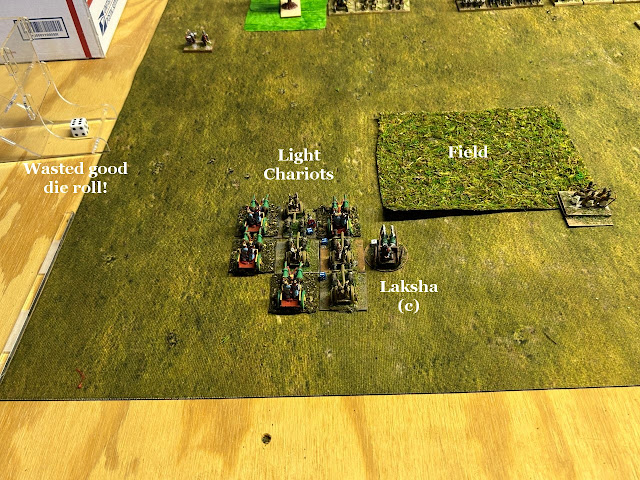 |
| Laksha takes the left with 8 chariots. |
With two pieces of terrain on the Vedic side of the board, the chariots can either be on the left, or center. Which is also a decision the Assyrians have to make for their chariots.
 |
| Brother Daksha's elephant command takes the center. |
 |
| Other brother Daksha takes the right. All mediocre bowman are fairly safe in the rough. |
 |
| The view from above. |
 |
| Seeing the elephants in the center, ܫܘܵܐ drives his chariots to the right. |
 |
| ܐܸܠܦܘܿܢܝܼܬ݂ܵܐ leads his Asharittu in the center, while ܢܵܩܹܫ deploys his Hupshu to the hill top. |
 |
| Laksha decides he has too many chariots in a small area and parses of 3 to deploy towards the center. |
 |
| Brother Daksha sends forward his skirmishers. |
 |
| And reinforces other brother Daksha's archers. |
Turn 2:
 |
| The Assyrians advance to bow range. Both sides loose arrows, but none strike home. |
 |
| A similar exchange in the center. |
 |
| The Assyrians are holding back their infantry battle lines and will wait till their chariots push through their lighter opponents. And no one is in a hurry to engage elephantry. |
 |
| Laksha moves forward, ZOCing the Assyrian chariots, but more importantly, providing evade room should they evade long. |
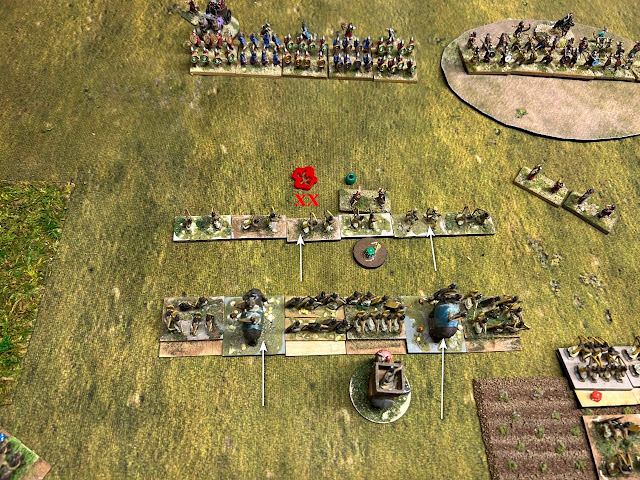 |
| Daksha charges the Assyrian skirmishers, and advances his elephants behind them. |
 |
| Other brother Daksha optimizes his firing line. |
Time for a bio break, and take some pictures of other actions.
And the view from the other side:
Turn 3:
 |
| The Assyrian "Light" chariots charge. They have an armor advantage, so Laksha's chariots evade, barely staying on the board. |
 |
| Assyrian Asharittu and Hupshu advance. Their skirmishers flank charge Daksha's skirmish line. |
 |
| The Hupshu line hovers just out of bow range and mostly on the hill. |
 |
| Laksha's chariots return to exchange arrows. They need to score some disorders to compensate for the Assyrian armor advantage. |
 |
| Laksha arrives in the center with two chariots. Daksha's elephants hold back for now. |
 |
| Other Brother Daksha holds back out of arrow range for now. |
This is a fairly good game of maneuvering and timing commitment.
Turn 4:
 |
| The Assyrian "Light" chariots charge. Their heavies coming forward for followup attacks. |
 |
| Assyrian lights flank charge the Vedic skirmishers, sending them fleeing into the rough |
 |
| The Hupshu advance and loose arrows. Scoring perfect down the line! |
 |
| Laksha and Daksha coordinate an attack on one Assyrian chariot. |
 |
| Daksha's elephantry charges the Asharittu line. Dispersing an Assyrian skirmisher in route. |
Luck ran better for Daksha then he deserved, with 3 contacts, with neither side losing.
 |
| Other brother Daksha also did better than average. Two successful rallies and 2 causing two missile disorders. |
 |
| The Assyrian heavies only had one gap to charge through. But the Vedic chariots rolled a point better. |
 |
| The battle in the center is just continuing. The line is drawn for the benefit of the reader. |
 |
| ܢܵܩܹܫ Hupshus commit to battle. |
At the top of the 5th, the score is 18 of 22 for the Assyrians, to 10 of 26 for the Vedics.
 |
| Laksha launches his counter-counter-attack! |
 |
| At the same time leads the attack against the right flank of the Asharittu line. |
 |
| The Hopshu charge, routing another Vedic warrior. |
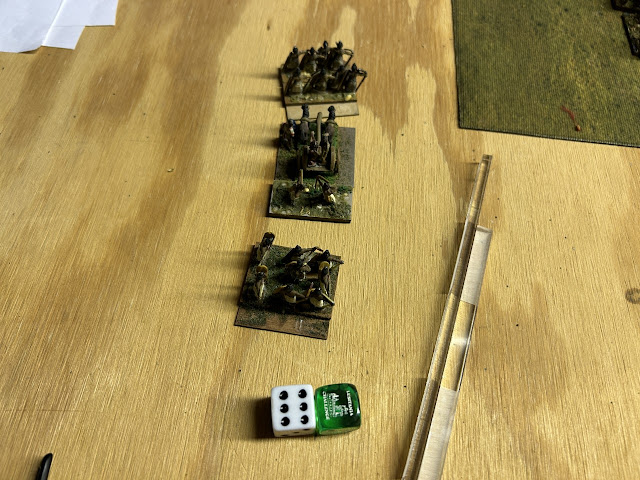 |
| The Vedic score is at 12 |
 |
| The Assyrians are at 19 |
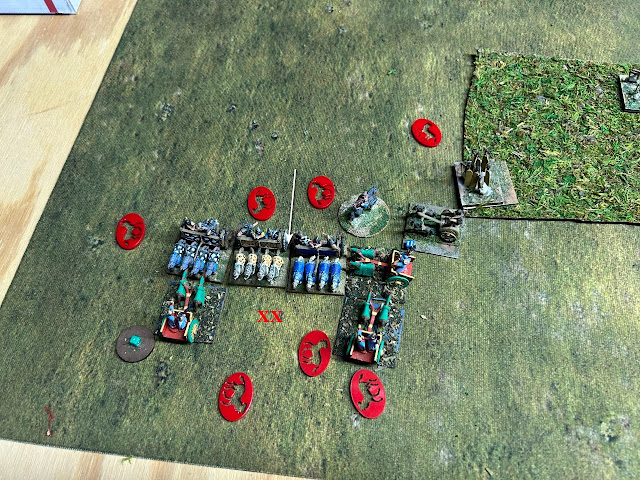 |
| The Assyrian heavy chariots charge, splintering a Vedic chariot. |
 |
| In the center, the battle mostly just continues, with the Vedic warriors nearly crumbling. A Hupshu warrior charges a Vedic elephant in the rear |
 |
| ܢܵܩܹܫ and other brother Daksha hurl both insults and arrows, with equal effect. |
We called it here as the Vedics had multiple locations to score the 2 points they needed for the win.
What went wrong? While it seemed a good idea to split the Vedic chariot command in two, it was also difficult with just a competent commander. Some of the decisions were based on a scarcity of command points.
There was a similar problem with the center command. "Brother" Daksha was brilliant, because elephants are difficult to drive. But combine that with the command parsing off two of their warriors both left and right, led to difficult command decisions as well.
And I want to say that the 2 Handed Weapon Swordsmen won exactly zero combats. Not one dice pairing was successful. The best they scored was a tie.
And that Assyrian skirmisher behind the lines? Richard forgot that was his until cleanup.



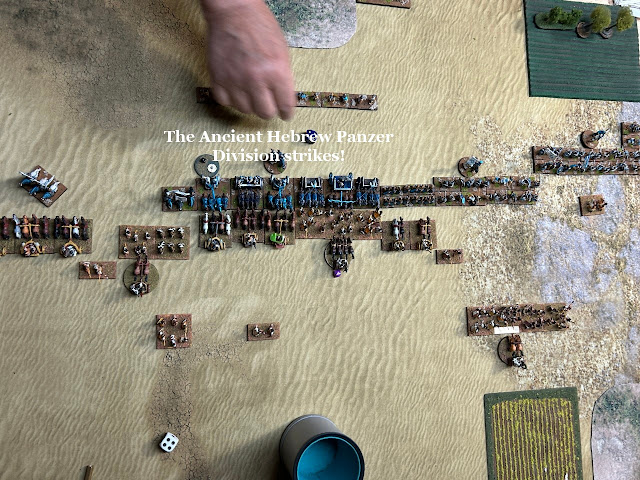



No comments:
Post a Comment